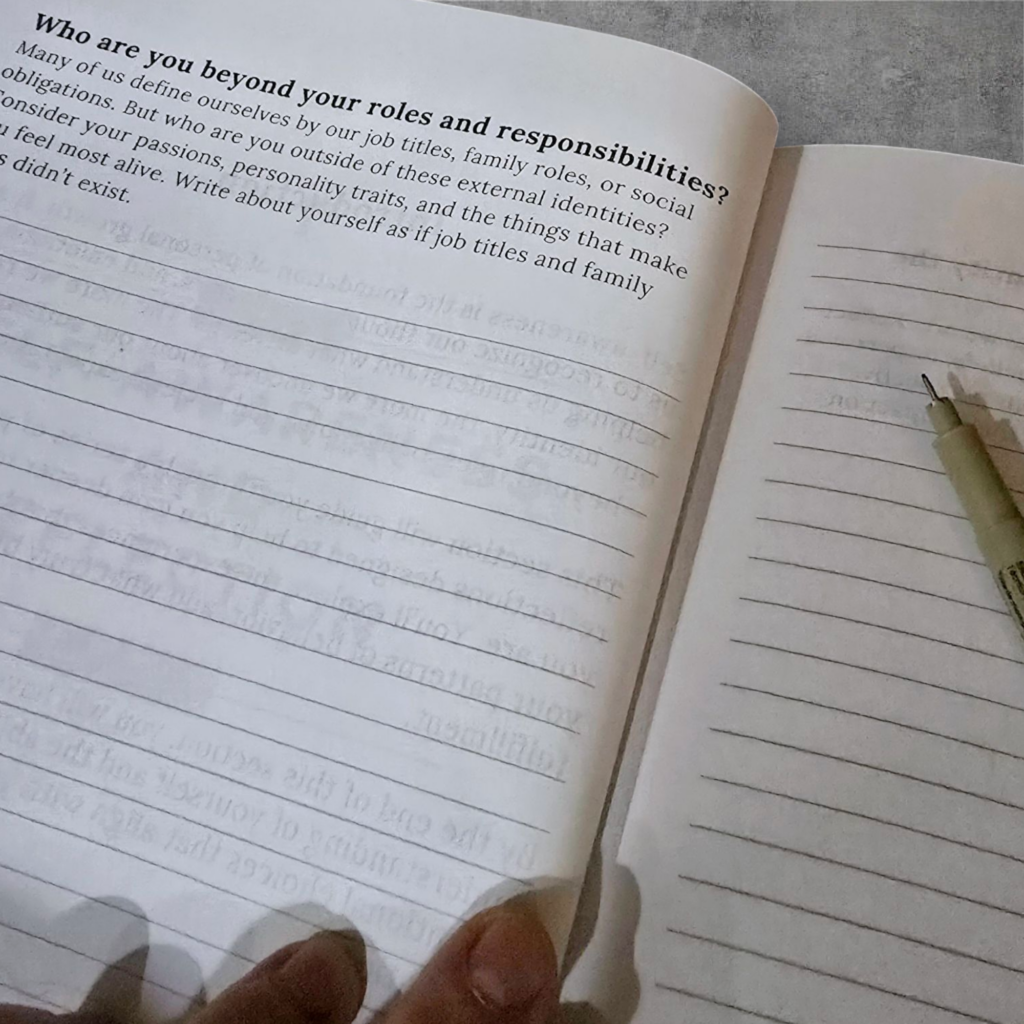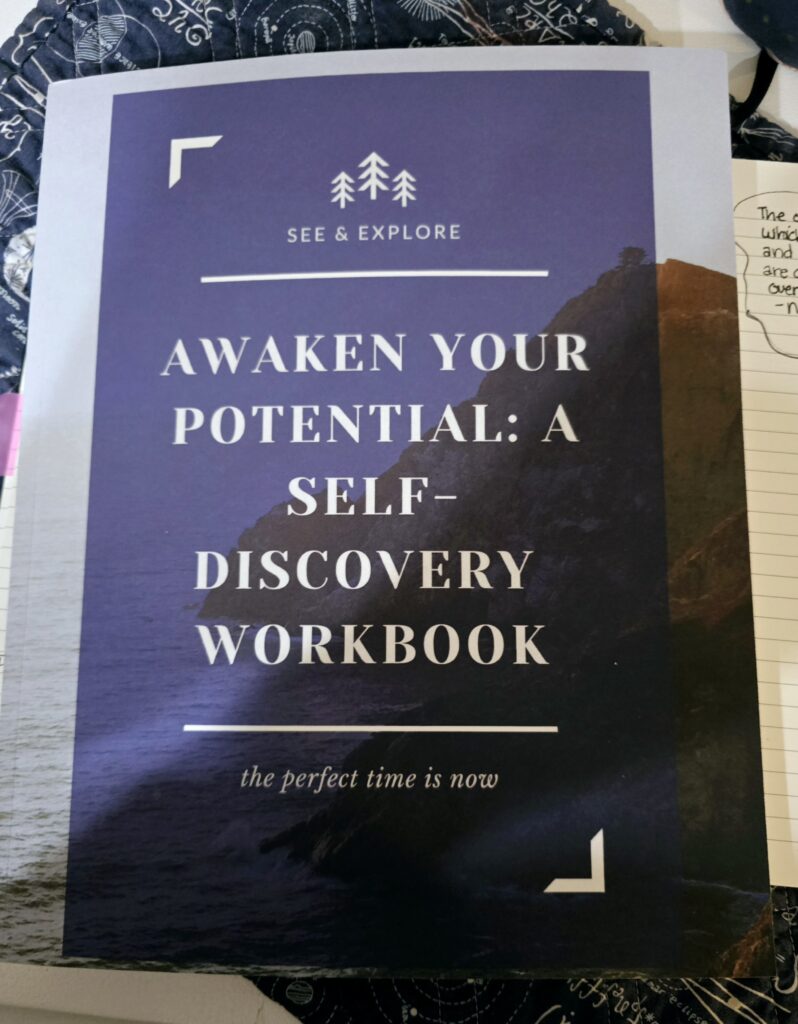Have you ever felt like you’re constantly juggling responsibilities—your job, family, projects, and everythiang else—only to realize you’re not quite sure who you are beyond those roles, how to answer “Who Am I?”
It’s a strange feeling, isn’t it? You might ask yourself:
“Who am I outside of my roles and responsibilities—outside my job, family roles, and obligations? What aspects of my personality, passions, and interests define me?”

For a lot of us, this question pops up in different ways:
- When you’re at a life transition (career change, empty nest, midlife reinvention).
- When you realize you’ve been focusing so much on others that you’ve lost touch with your own passions.
- When you want to start a new chapter but don’t know what excites you anymore.
If you’ve ever felt this way, you’re not alone. I’ve been there too. But I’ve found that instead of getting stuck, the best way to find clarity is to write through it—exploring who you are through structured prompts and reflection exercises.
In this post, I’ll walk you through five steps to help you answer the question, “Who am I?” in a way that feels natural, not overwhelming. By the end, you’ll have a clearer picture of what makes you, you.
Step 1: Break Down the Question

Instead of trying to answer “Who am I?” all at once, break it down into smaller, more approachable pieces.
Remove External Labels
For a moment, forget your job title, family roles, and daily responsibilities. Instead, focus on what excites you, interests you, and makes you feel alive.
Try This: The “I Am…” Exercise
Start with simple statements that reveal your essence:
- I am curious about…
- I feel most alive when…
- I am drawn to…
- I lose track of time when…
✏ Example Answer:
“I lose track of time when I’m deep in a creative project—whether it’s writing, designing something new, or capturing a moment with my camera. I feel most alive when I’m moving—hiking, exploring, or tackling a new challenge. I am drawn to the idea of reinvention, constantly learning and pushing myself to grow.”
Already, you’re starting to paint a picture of who you are.
What did you discover about yourself in this exercise? Comment below or jot it down in your journal.
Step 2: Use Structured Writing Prompts

If you find it hard to write about yourself, structured prompts make it easier.
Prompt 1: Imagine a Completely Free Day
If you had no obligations—no work, no responsibilities—what would you do?
- What’s the first thing you’d do in the morning?
- Where would you go?
- What projects or activities would you naturally gravitate toward?
✏ Example Answer:
“If I had a completely free day, I’d start with a long walk, letting my mind wander with ideas. I’d spend my midday creating—writing, designing, or brainstorming new business ideas. In the evening, I’d reflect, maybe journaling about what I learned, knitting while watching a show, or planning my next adventure.”
This exercise helps you identify what truly excites you outside of obligations.
Prompt 2: Look for Patterns in What You Love
Make a list of:
- Activities that make you feel energized
- Topics you naturally research or get excited about
- Small everyday moments that bring joyLook for common themes—they reveal your true interests.
✏ Example List:
- Creative Work – Writing, designing, crafting
- Movement & Adventure – Hiking, exploring new places
- Learning & Growth – Reading, researching new skills
- Freedom & Reinvention – Creating my own path, building something from scratch
Step 3: Use Storytelling Instead of Listing Traits

Many people struggle to describe themselves because they rely on adjectives instead of experiences. The key to better writing and self-expression is storytelling.
Instead of This:
“I love adventure and creativity.“
Try This:
“There’s a moment on every hike when I stop thinking about everything else and just feel completely present—just me, the trail, and whatever’s ahead. It’s the same feeling I get when I’m deep in a creative project, when the rest of the world fades and I’m fully engaged in the process of making something new.“
See the difference? The second version shows your personality instead of just listing traits.
✏ Exercise:
Think of a time you felt completely in your element. Write it as a short scene, bringing the reader into your experience.
Step 4: Try Alternative Writing Methods

Not everyone finds traditional journaling easy. If you struggle with writing, try alternative methods to express your thoughts.
1. Voice Memo Journaling
Some people express themselves better through talking rather than writing. Try recording a voice memo answering the question “Who am I beyond my roles?”, then transcribe and refine your thoughts later.
2. Write in Third Person
Describe yourself as if a friend were introducing you.
✏ Example:
“Krista is the kind of person who gets obsessed with an idea, researches it relentlessly, and then dives in headfirst. She loves making things—whether it’s knitting, cooking, photography, or designing a new product. She’s always planning something, always thinking about how to improve and grow. She sees possibilities everywhere.”
3. “Two Truths and a Why”
Write two true statements about yourself and one explanation of why they matter to you.
✏ Example:
- I love designing and creating things by hand.
- I constantly seek new challenges and learning experiences.
- Why? Because creating and learning make me feel like I’m moving forward, and I love the process of discovery.
Step 5: Make Reflection a Habit

Self-discovery isn’t a one-time exercise—it’s an ongoing process. Try setting up a regular reflection practice to keep exploring your identity and passions.
✅ Set a timer for 10 minutes once a week and free-write your thoughts.
✅ Keep a “What Excites Me” list to track what consistently draws your interest.
✅ Experiment with different formats (writing, voice memos, storytelling).
Like any adventure, self-discovery gets easier the more you explore. The more you write, reflect, and experiment, the clearer your path will become.
Unlocking Your Potential Starts Here
If you found this helpful and want more, this is just one of many exercises in my Awaken Your Potential: A Self-Discovery Workbook. It’s designed for people like us—curious, creative, always evolving—who want to take a deeper look at what truly excites them and start taking action.
✨ Grab your copy HERE – (Available as a PDF download or in print on Amazon.)”

Think of this as the first step in an adventure—one where you’re exploring the most important terrain of all: yourself.
